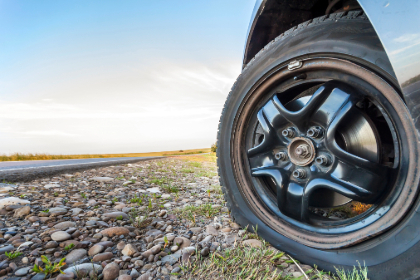INDEPENDENT DEALER
Clermont, FL | (918) 269-0081
OUR BLOG
Noticing balding treads or shaky rides? Spot the signs you need new tires before it’s too late. K&K Oils and Lube in Clermont, FL, has the tips you need to stay safe.

Your tires play a big role in keeping your car safe, responsive, and fuel-efficient. But as they age or wear out, they can become a real hazard. Worn tires increase your risk of blowouts, reduce traction, and make handling unpredictable, especially in rain or snow. In this post, we’ll cover the most common signs you need new tires so you can stay ahead of any problems and drive with confidence.
Looking for premium engine protection? Stop by K&K Oilsandlube in Clermont, FL, for AMSOIL products that deliver. Questions? Call (918) 269-0081. Stock up anytime with AMSOIL’s online store!
1. You Fail the Penny Test
When it comes to checking the tread depth, the penny test is a quick and easy way to tell if you need to replace your tires. Just take a penny and insert it into the tire’s tread groove with Lincoln’s head facing down. If you can see the top of his head, your tread is dangerously low (less than 2/32 of an inch). Low tread means poor grip, especially in wet or snowy conditions. If you fail this simple test, it’s time for new tires.
2. Cracked or Dry Sidewalls
Take a close look at your tire sidewalls. Do you see cracks or dry, flaky rubber? These cracks often form from age or exposure to extreme heat and sun. While they might seem small, they’re early warning signs of a blowout. Sidewall failure at highway speeds can be sudden and dangerous. Don’t take the risk.
3. Bulges or Blisters on the Tire
Notice a bump or bubble on your tire? That’s a bulge, and it’s serious. Bulges happen when the inner lining is damaged (usually from hitting potholes or curbs), and air pushes out to the outer rubber layer. This weak spot can explode without warning. If you see one, replace the tire right away.
4. Uneven Tread Wear
Tires should wear down evenly. If one side looks more worn than the other, or if you notice odd patterns like cupping or bald spots, you’ve got a problem. Uneven wear often means bad alignment, incorrect pressure, or suspension trouble. It also shortens tire life and messes with handling. Get it checked out!
Tire safety starts with the right tools. To ensure proper inflation, pick up an AMSOIL Tire Depth Gauge at K&K Oilsandlube in Clermont, FL, anytime! Call (918) 269-0081 to grab yours. Don’t forget to stock up on all your car care essentials at AMSOIL’s online store!
5. Tires Are Older Than 6 Years
Tire rubber breaks down over time, even if the tread’s still left. Most manufacturers recommend replacing tires every 6 to 10 years. You can check the age by finding the DOT code on the tire sidewall. If your tires are over 6 years old, it’s smart to start planning a replacement.
6. Poor Traction in Wet or Icy Conditions
Do you feel like your car is sliding in the rain? Skidding or hydroplaning is a major red flag. Loss of traction is a sign that your tread is too shallow to grip the road properly. When your car feels less steady or takes longer to stop, don’t ignore it. It’s one of the most dangerous signs that you need new tires.
7. Frequent Air Pressure Loss
Tires that keep losing air may have a slow leak, a puncture, or sidewall damage. It could also mean your valve stem is failing. No matter the cause, a tire that won’t hold air puts you at risk for a blowout. Don’t keep refilling; get it checked out.
8. Vibrations or a Rough Ride
A bumpy ride or unusual vibration might mean internal tire damage or imbalance. You might also be dealing with tire separation or uneven wear. These issues not only affect comfort, they can damage your suspension and lead to dangerous tire failure.
Conclusion: Don’t Wait for a Blowout
Your tires are your vehicle’s only contact with the road, so regular checks are a must. Look over your tires once a month or before any long trip. Watch for the warning signs we’ve listed, and don’t ignore your gut feeling if something feels off. If you notice any signs you need new tires, visit a tire professional to be sure. Replacing tires on time keeps you, your passengers, and everyone else on the road much safer.